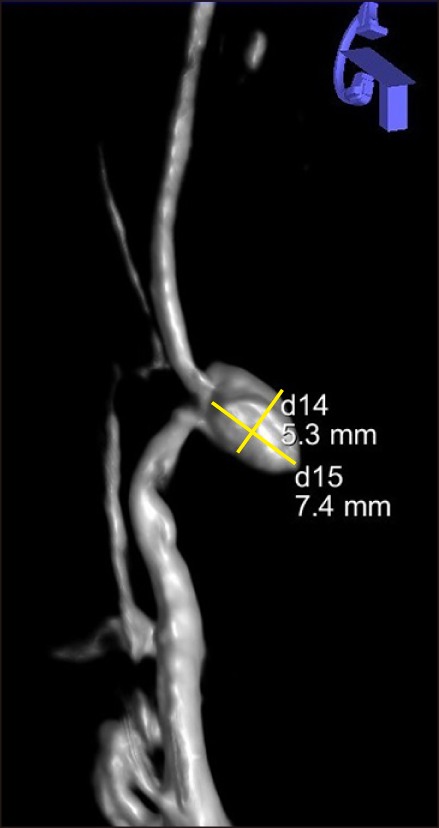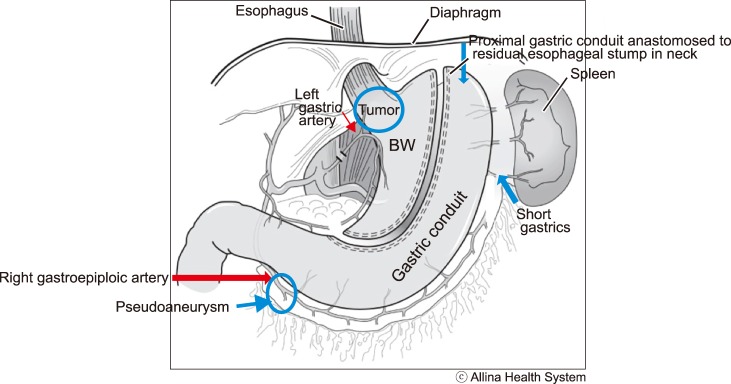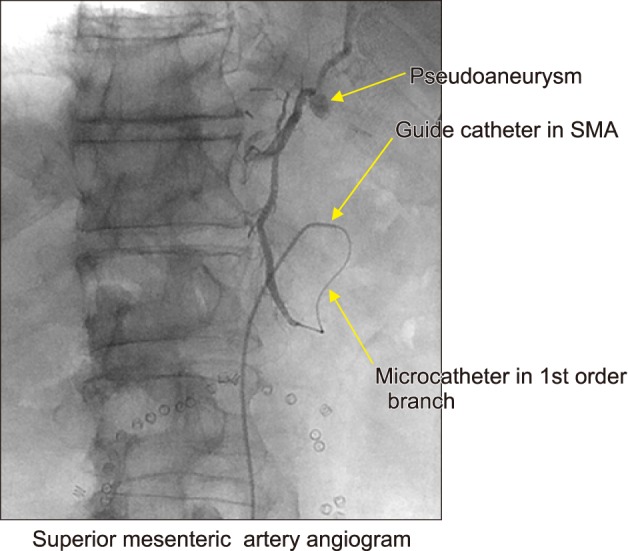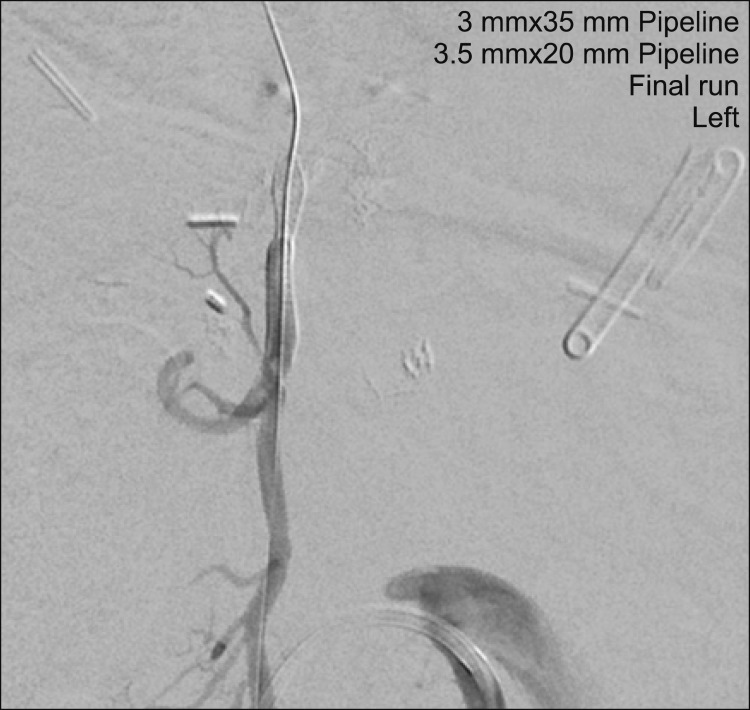Ann Hepatobiliary Pancreat Surg.
2020 Feb;24(1):114-118. 10.14701/ahbps.2020.24.1.114.
Successful treatment of visceral pseudoaneurysm after pancreatectomy using flow-diverting stent device
- Affiliations
-
- 1Division of Transplantation and Hepatopancreatobiliary Surgery, Department of Surgery, Mayo Clinic, Phoenix, AZ, USA. EGiorgakis@uams.edu
- 2Department of Solid Organ Transplantation, University of Arkansas for Medical Sciences, Little Rock, AR, USA.
- 3Division of Neuroradiology, Department of Radiology, Mayo Clinic, Phoenix, AZ, USA.
- 4Department of Interventional Radiology, Mayo Clinic, Phoenix, AZ, USA.
- 5Division of Cardiovascular and Thoracic Surgery, Department of Surgery, Mayo Clinic, Phoenix, AZ, USA.
- KMID: 2471200
- DOI: http://doi.org/10.14701/ahbps.2020.24.1.114
Abstract
- Aim of the study is the description of the successful management of gastroepiploic artery pseudoaneurysm with preservation of parent vessels using flow-diversion technology. The present report describes the application of a flow-diversion Pipelineâ„¢ Flex device for occlusion of a sidewall bleeding pseudoaneurysm on a patient who was status-post sub-total pancreatectomy and remote esophagectomy with a gastric conduit. The pseudoaneurysm was on the solitary vessel supplying the patient's conduit. Use of flow diversion technology excluded the sidewall pseudoaneurysm while maintaining gastric conduit perfusion. In our case, the application of flow diversion technology allowed the preservation of patency of the main arterial supply to the gastric conduit on a post-esophagectomy patient; loss of the right gastroepiploic artery in that case would had been otherwise catastrophic. Flow-diversion technology can be considered for the treatment of pseudoaneurysms post-pancreatic resections, especially when there is no other surgical or endovascular treatment option.
Keyword
MeSH Terms
Figure
Reference
-
1. Lubezky N, Goykhman Y, Nakache R, Kessler A, Baruch R, Katz P, et al. Early and late presentations of graft arterial pseudoaneurysm following pancreatic transplantation. World J Surg. 2013; 37:1430–1437. PMID: 23456259.
Article2. Harvey J, Dardik H, Impeduglia T, Woo D, DeBernardis F. Endovascular management of hepatic artery pseudoaneurysm hemorrhage complicating pancreaticoduodenectomy. J Vasc Surg. 2006; 43:613–617. PMID: 16520182.
Article3. Pang TC, Maher R, Gananadha S, Hugh TJ, Samra JS. Peripancreatic pseudoaneurysms: a management-based classification system. Surg Endosc. 2014; 28:2027–2038. PMID: 24519028.
Article4. Shrikhande GV, Khan SZ, Gallagher K, Morrissey NJ. Endovascular management of superior mesenteric artery pseudoaneurysm. J Vasc Surg. 2011; 53:209–211. PMID: 21184935.
Article5. Jain G, Kathuria S, Nigam A, Trehan VK. Transcatheter embolization of a giant pancreatic pseudoaneurysm: a tale of two bleeds and one thrombus. Indian Heart J. 2013; 65:91–94. PMID: 23438621.
Article6. Onizawa S, Hamano M, Tsuchiya A, Araida T, Toda J, Yamamoto M. Successful treatment of pseudoaneurysm rupture after pylorus preserving pancreaticoduodenectomy by covered stent placement. Surg Technol Int. 2012; 22:77–82. PMID: 23065804.7. Radeleff B, Noeldge G, Heye T, Schlieter M, Friess H, Richter GM, et al. Pseudoaneurysms of the common hepatic artery following pancreaticoduodenectomy: successful emergency embolization. Cardiovasc Intervent Radiol. 2007; 30:129–132. PMID: 16933158.
Article8. Won Y, Lee SL, Kim Y, Ku YM. Clinical efficacy of transcatheter embolization of visceral artery pseudoaneurysms using N-butyl cyanoacrylate (NBCA). Diagn Interv Imaging. 2015; 96:563–569. PMID: 25686776.
Article9. Hyare H, Desigan S, Nicholl H, Guiney MJ, Brookes JA, Lees WR. Multi-section CT angiography compared with digital subtraction angiography in diagnosing major arterial hemorrhage in inflammatory pancreatic disease. Eur J Radiol. 2006; 59:295–300. PMID: 16542810.
Article10. Becske T, Kallmes DF, Saatci I, McDougall CG, Szikora I, Lanzino G, et al. Pipeline for uncoilable or failed aneurysms: results from a multicenter clinical trial. Radiology. 2013; 267:858–868. PMID: 23418004.
Article11. Awad AJ, Mascitelli JR, Haroun RR, De Leacy RA, Fifi JT, Mocco J. Endovascular management of fusiform aneurysms in the posterior circulation: the era of flow diversion. Neurosurg Focus. 2017; 42:E14.
Article12. Dolati P, Eichberg DG, Thomas A, Ogilvy CS. Application of pipeline embolization device for iatrogenic pseudoaneurysms of the extracranial vertebral artery: a case report and systematic review of the literature. Cureus. 2015; 7:e356. PMID: 26623211.
Article13. Adrahtas D, Jasinski P, Koullias G, Fiorella D, Tassiopoulos AK. Endovascular treatment of a complex renal artery aneurysm using coils and the pipeline embolization device in a patient with a solitary kidney. Ann Vasc Surg. 2016; 36:291.e5–291.e9.
Article
- Full Text Links
- Actions
-
Cited
- CITED
-
- Close
- Share
- Similar articles
-
- A Case of Migration of Pipeline Embolization Device Causing Rupture during Treatment of an Unruptured Vertebral Artery Dissecting Aneurysm
- Delayed Proximal Flow Diverting Stent Migration in a Ruptured Intracranial Aneurysm: A Case Report
- Conjoined Stent Technique for Radiation Induced Long Segment Carotid Stenosis and Pseudoaneurysm
- Symptomatic Post Endarterectomy Common Carotid Artery Pseudoaneurysm Treated with Combination of Flow Diverter Implantation and Carotid Stenting
- Nationwide Mortality Data after Flow-Diverting Stent Implantation in Korea





